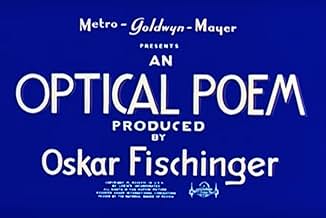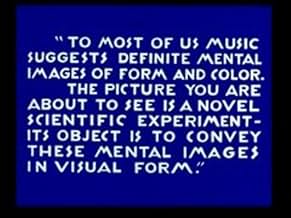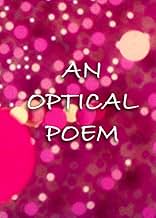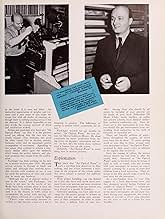Agrega una trama en tu idiomaMental imagery of music is visualized with two-dimensional shapes dancing to the rhythm of Franz Liszt's Hungarian Rhapsody No. 2.Mental imagery of music is visualized with two-dimensional shapes dancing to the rhythm of Franz Liszt's Hungarian Rhapsody No. 2.Mental imagery of music is visualized with two-dimensional shapes dancing to the rhythm of Franz Liszt's Hungarian Rhapsody No. 2.
- Dirección
Opiniones destacadas
This is from a collection of art films entitled "Unseen Cinema: Early American Avant-Garde Film 1894-1941". Unlike most of the other films in this set, this one is from a major studio--MGM. Somehow Oskar Fischinger was able to convince the MGM folks to sponsor this art film that consists of hundreds of paper cut-outs that are hung from invisible wires and which are shot, one frame at a time---all in synchronization with music from Franz Liszt. It's all in color and it's amazing that such a non-commercial sort of project was funded by this or any studio.
While it's not at all fun, it is an amazing film to watch. Not only is it wonderfully synchronized, but works so very well. It's all very hypnotic and amazing--even when you see it today. It must have taken forever practically to make this--and perhaps this is why this is Fischinger's only film. Strange but well worth seeing.
While it's not at all fun, it is an amazing film to watch. Not only is it wonderfully synchronized, but works so very well. It's all very hypnotic and amazing--even when you see it today. It must have taken forever practically to make this--and perhaps this is why this is Fischinger's only film. Strange but well worth seeing.
The tagline for Disney's 'Fantasia (1940)' read: "Hear the pictures! See the music!" This is, in effect, what Oskar Fischinger was doing with his animation – communicating music to the deaf, giving visual life to music using colours and geometric patterns. His approach, though later imitated by Walt Disney, was largely appreciated outside the mainstream. However, 'Allegretto (1936)' and 'An Optical Poem (1937)' were both commissioned by big studios – Paramount and MGM, respectively {however, the former film was inconceivably stifled into a black-and-white release}. It was a little novel, I'll admit, to see such an abstract cartoon presented under the MGM banner, and, indeed, it seems that the studio was understandably cautious; they bizarrely introduce 'An Optical Poem' as a "scientific" experiment.
Fischinger's film uses patterns of oscillating circles, paper cutouts dangling from invisible wires, synchronised to Franz Liszt's "Hungarian Rhapsody No. 2." The animation itself resembles a journey through outer space. The orbiting circles are akin to moons orbiting planets, planets orbiting the sun, and there's an unmistakable image of a comet hurtling across the night sky. The overall effect of the space-themed visuals and accompanying classical musical is not all that dissimilar to Kubrick's use of the "Blue Danube" waltz during '2001: A Space Odyssey (1968).' Fischinger seems to be suggesting that to fully articulate such magnificent music is beyond the grasp of our earthly minds – to do so, we must utilise objects far beyond our mortal scope. Most incredibly of all, Fischinger reconstructed these great objects using little more than coloured paper and wire.
Fischinger's film uses patterns of oscillating circles, paper cutouts dangling from invisible wires, synchronised to Franz Liszt's "Hungarian Rhapsody No. 2." The animation itself resembles a journey through outer space. The orbiting circles are akin to moons orbiting planets, planets orbiting the sun, and there's an unmistakable image of a comet hurtling across the night sky. The overall effect of the space-themed visuals and accompanying classical musical is not all that dissimilar to Kubrick's use of the "Blue Danube" waltz during '2001: A Space Odyssey (1968).' Fischinger seems to be suggesting that to fully articulate such magnificent music is beyond the grasp of our earthly minds – to do so, we must utilise objects far beyond our mortal scope. Most incredibly of all, Fischinger reconstructed these great objects using little more than coloured paper and wire.
Optical Poem, An (1937)
*** (out of 4)
This 6-minute animated short is considered by many to have been the inspiration for Disney's FANTASIA. This film contains various animated images being played to Franz Liszt's Hungarian Rhapsody No. 2 and makes for quite a ride. In his day, director Fischinger was pretty much overlooked and after during down a job offer from Disney, he would eventually be fired by both MGM and Paramount. His animation career never took off in the movies but years later his work began to be reevaluated and today's he's considered one of the best. This, considered his best film, is pretty strong in terms of its visual style even though it's rather simple. A blue background with various circles, squares and other images. The film moves along quite well, although the six-minutes do start to get a bit long towards the end.
*** (out of 4)
This 6-minute animated short is considered by many to have been the inspiration for Disney's FANTASIA. This film contains various animated images being played to Franz Liszt's Hungarian Rhapsody No. 2 and makes for quite a ride. In his day, director Fischinger was pretty much overlooked and after during down a job offer from Disney, he would eventually be fired by both MGM and Paramount. His animation career never took off in the movies but years later his work began to be reevaluated and today's he's considered one of the best. This, considered his best film, is pretty strong in terms of its visual style even though it's rather simple. A blue background with various circles, squares and other images. The film moves along quite well, although the six-minutes do start to get a bit long towards the end.
10verbusen
Listed as a 1938 film but perhaps first shown in 1937 since the TCM website states that as the year audiences first viewed An Optical Poem, this was a pioneering animation short. I'm surprised I never watched it before the year 2019, TCM should be showing it more often (and other stop-motion independent shorts from the time). While watching this short I began to think of how it was made. It's using stop motion, taking a picture of the scene and then moving the items in the frame a slight bit at a time and taking another picture and so many thousands of times. TCM has a lot of information about this short. It was done with cut out paper patterns held together by fishing line, no computers back then! It could have been done with animation but when you realize it is being done with stop motion it adds credibility to the degree of work involved in producing the film. MGM, a very conservative studio, paid Oskar Fischinger $11,000 to make the film. Anything he had left over was his to keep. The only problem was there was nothing left over, so Oskar, while he may have wanted to make some money, did this one for the love of his art. It was not widely released and was used as a "prestige" item, playing for high end movie audiences, like as the TCM article states, "first-class ocean-liner passengers". Many at the time thought it would be nominated for an Academy Award (it was not). Mr Fischinger would have a falling out with MGM over the money made from the film that included a physical altercation with MGM staff and his arrest, he would only do 5 more independent shorts before losing interest in film-making and devoting his work to painting instead. MGM, which was using an outside studio before for its animated shorts at the time, the Harmon-Ising studio and their Happy Harmonies series, around the time of An Optical Poem, created their own animation department resulting in many future Oscar winners from the Tom and Jerry franchise. This is the story of An Optical Poem, quite an interesting one not only on how it was made and the level of sophistication it presented in 1937 with its high fidelity sound, brilliant technicolor photography and inspired use of stop motion animation, but for the way mainstream audiences and Hollywood basically rejected it as being too far ahead of its time. For film history buffs it marks an achievement in film making and a time capsule on the social attitudes towards modern artists in the 1930s. 10 of 10.
What makes me chuckle about this short film is that MGM actually financed it! Who'd have thought that such attitudes were ever present at the big studios? The intertitle at the start calls the movie a "scientific experiment"*, gawd those guys were dumb. Anyway they let Fischinger get on with his business so I can't complain. The second time I watched it I really was dumbfounded by the MGM logo, for once, ars gratia artis actually meant something! Anyway the film is a visual accompaniment to Liszt's Hungarian Rhapsody no.2. Fischinger chose his music really well because there are lots of sea changes within the piece that allows him to do something totally different at the mood switches. He uses coloured paper circles and stop motion animation, to create a geometrical ballet. He must have done a lot of work because the movements are all very smooth. In fact it's really a masterpiece of technical craft and almost unbelievable how synchronised the animation is to the music.
It brought a big smile to my face and that's really rare.
* "To most of us, music suggests definite mental images of form and colour. The picture you are about to see is a novel scientific experiment. Its object is to convey these mental images in visual form"
It brought a big smile to my face and that's really rare.
* "To most of us, music suggests definite mental images of form and colour. The picture you are about to see is a novel scientific experiment. Its object is to convey these mental images in visual form"
¿Sabías que…?
- TriviaAs this was released two years before "Fantasia," it's reasonable to assume either Disney or someone who worked for him saw this and realized the possibilities of non-narrative animation set to classical music; certainly the "Toccata and Fugue in D Minor" sequence bears a striking similarity.
- Citas
Prologue (Title): To most of us music suggests definite mental images of form and color. The picture you are about to see is a novel scientific experiment - Its object is to convey these mental images in visual form.
Selecciones populares
Inicia sesión para calificar y agrega a la lista de videos para obtener recomendaciones personalizadas
Detalles
- Fecha de lanzamiento
- País de origen
- Idioma
- También se conoce como
- MGM Miniatures (1937-1938 Season) #5: An Optical Poem
- Productora
- Ver más créditos de la compañía en IMDbPro
- Tiempo de ejecución6 minutos
- Relación de aspecto
- 1.37 : 1
Contribuir a esta página
Sugiere una edición o agrega el contenido que falta




















